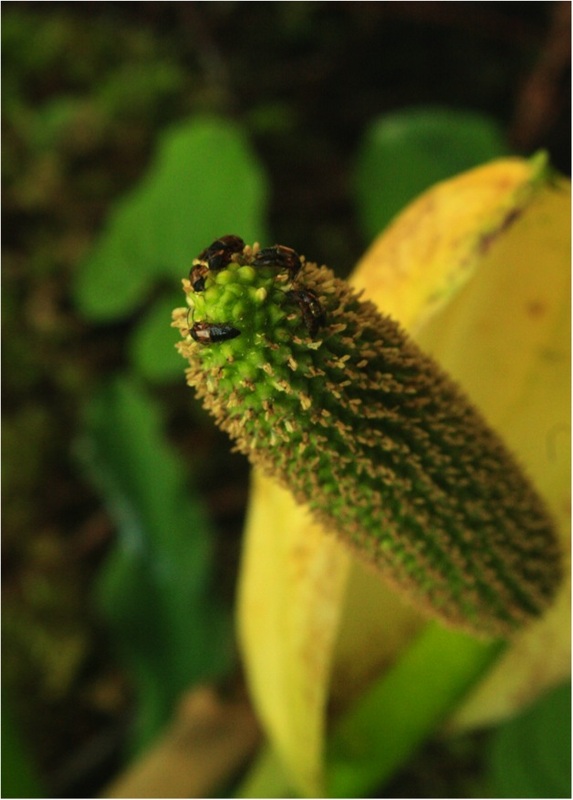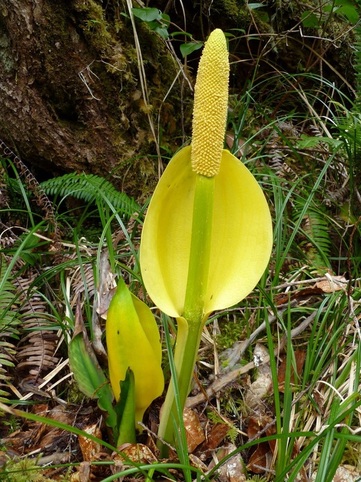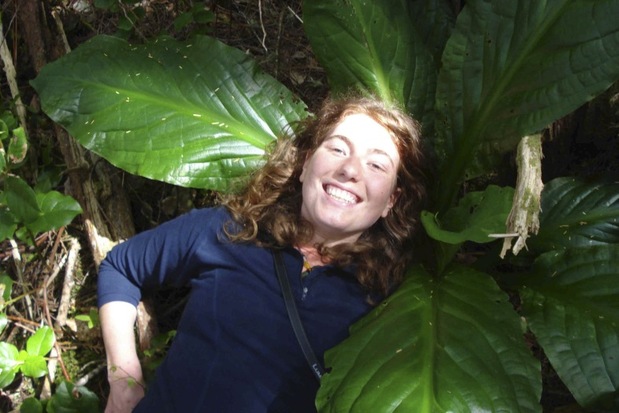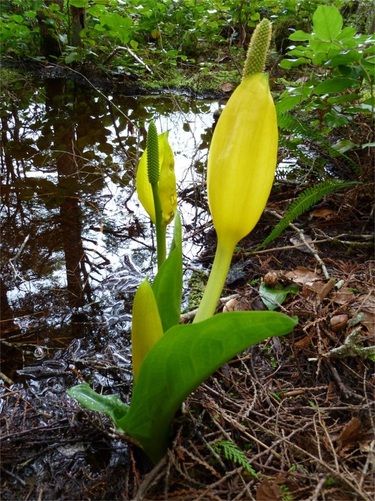Skunk cabbage, American skunk cabbage, swamp lantern, western skunk cabbage, yellow skunk cabbage • Lysichiton americanus
Skunk cabbage in boggy areas on Calvert Island. Top right: ES 470 student Jennifer Elliot provides a size comparison for this large plant. Photos by Yuhei Iida (top left) and ES 470 students.
Identification
Skunk cabbage is a large bright green and yellow plant which flowers in the spring and summer. Its fleshy stems and leaves can reach heights and lengths of up to 1.5 m. The green leaves are all basal and attach to underground stems. The flowers are small and greenish-yellow, growing from a single large stalk. The large yellow 'hood' around the flower stalk is actually a bract, the botanical term for a specialized leaf associated with reproduction.
Habitat & Range
Skunk cabbage is found in wet habitats, including fens, muskeg, wet forest, wet meadows and swamps, at low to middle elevations. Its range extends from Alaska south to California, and east across inland BC and to Wyoming and Montana in the US.
Human Uses
Skunk cabbage was not generally traditionally eaten by First Nations, except as a famine food in the early spring; in such cases it was steamed or roasted first. The leaves, with their waxy coating, have been referred to as 'Indian wax paper,' and were used as a lining for baskets, steaming pits, wrapping salmon and other items.
Skunk cabbage features in some First Nations stories, including one from the Kathlamet where there was no salmon, so people ate many roots and leaves, including skunk cabbage. When spring salmon first came, Skunk Cabbage spoke to them and brought them to land, where people were able to eat them. Skunk cabbage was rewarded with an elk-skin blanket and a war club, and put in the rich, soft soil near the river (Haskin, 1934, as quoted in Pojar and MacKinnon, 1994).
Intriguing Info
Skunk cabbage is so named because of the smell it gives off, especially when it is in flower. While not as repugnant as the Corpse Flower of Sumatra, some people find the smell quite offensive.
For more interesting facts and opinions about skunk cabbage, click here.
Skunk cabbage is a large bright green and yellow plant which flowers in the spring and summer. Its fleshy stems and leaves can reach heights and lengths of up to 1.5 m. The green leaves are all basal and attach to underground stems. The flowers are small and greenish-yellow, growing from a single large stalk. The large yellow 'hood' around the flower stalk is actually a bract, the botanical term for a specialized leaf associated with reproduction.
Habitat & Range
Skunk cabbage is found in wet habitats, including fens, muskeg, wet forest, wet meadows and swamps, at low to middle elevations. Its range extends from Alaska south to California, and east across inland BC and to Wyoming and Montana in the US.
Human Uses
Skunk cabbage was not generally traditionally eaten by First Nations, except as a famine food in the early spring; in such cases it was steamed or roasted first. The leaves, with their waxy coating, have been referred to as 'Indian wax paper,' and were used as a lining for baskets, steaming pits, wrapping salmon and other items.
Skunk cabbage features in some First Nations stories, including one from the Kathlamet where there was no salmon, so people ate many roots and leaves, including skunk cabbage. When spring salmon first came, Skunk Cabbage spoke to them and brought them to land, where people were able to eat them. Skunk cabbage was rewarded with an elk-skin blanket and a war club, and put in the rich, soft soil near the river (Haskin, 1934, as quoted in Pojar and MacKinnon, 1994).
Intriguing Info
Skunk cabbage is so named because of the smell it gives off, especially when it is in flower. While not as repugnant as the Corpse Flower of Sumatra, some people find the smell quite offensive.
For more interesting facts and opinions about skunk cabbage, click here.
References
Pojar, J. and MacKinnon, A. (2005). Plants of Coastal British Columbia, Revised. Vancouver, BC: Lone Pine Publishing. P. 334.
Authors and editors of page
Chanda Brietzke and Brian Starzomski (2013).
Pojar, J. and MacKinnon, A. (2005). Plants of Coastal British Columbia, Revised. Vancouver, BC: Lone Pine Publishing. P. 334.
Authors and editors of page
Chanda Brietzke and Brian Starzomski (2013).







